Abstract
A plate assay was developed for the detection of anaerobic bacteria that produce azoreductases. With this plate assay, 10 strains of anaerobic bacteria capable of reducing azo dyes were isolated from human feces and identified as Eubacterium hadrum (2 strains), Eubacterium spp. (2 species), Clostridium clostridiiforme, a Butyrivibrio sp., a Bacteroides sp., Clostridium paraputrificum, Clostridium nexile, and a Clostridium sp. The average rate of reduction of Direct Blue 15 dye (a dimethoxybenzidine-based dye) in these strains ranged from 16 to 135 nmol of dye per min per mg of protein. The enzymes were inactivated by oxygen. In seven isolates, a flavin compound (riboflavin, flavin adenine dinucleotide, or flavin mononucleotide) was required for azoreductase activity. In the other three isolates and in Clostridium perfringens, no added flavin was required for activity. Nondenaturing polyacrylamide gel electrophoresis showed that each bacterium expressed only one azoreductase isozyme. At least three types of azoreductase enzyme were produced by the different isolates. All of the azoreductases were produced constitutively and released extracellularly.
Full text
PDF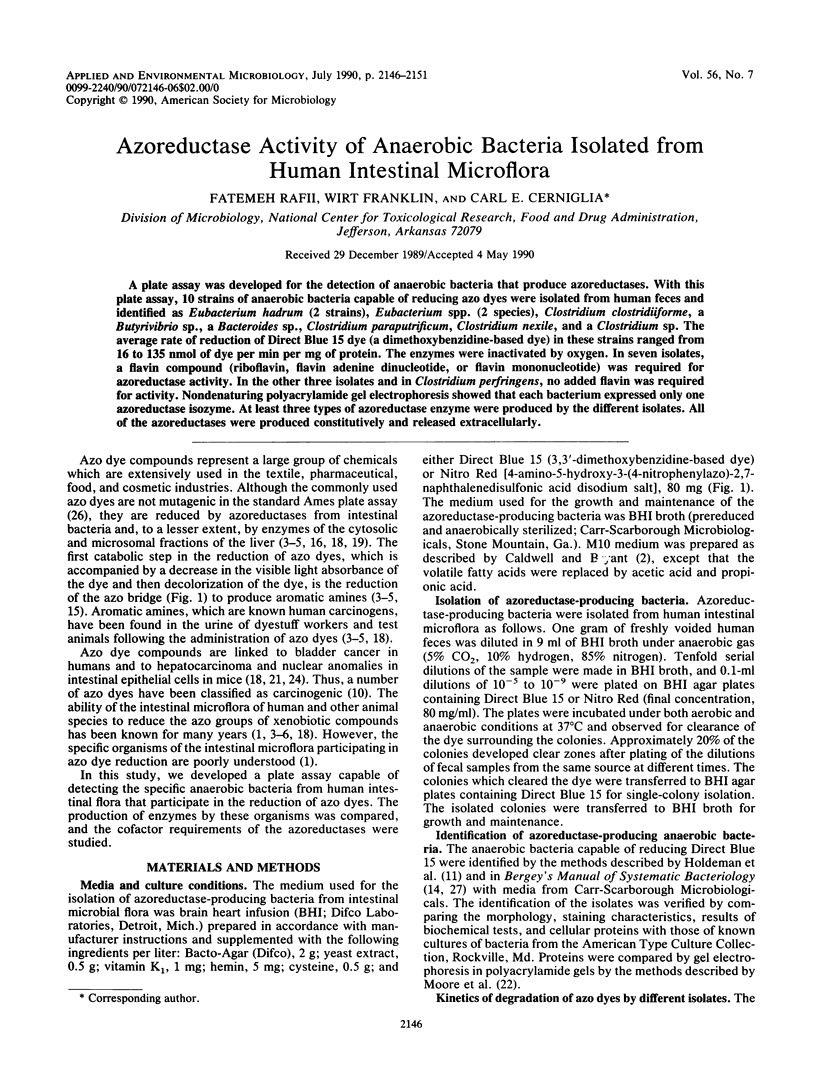
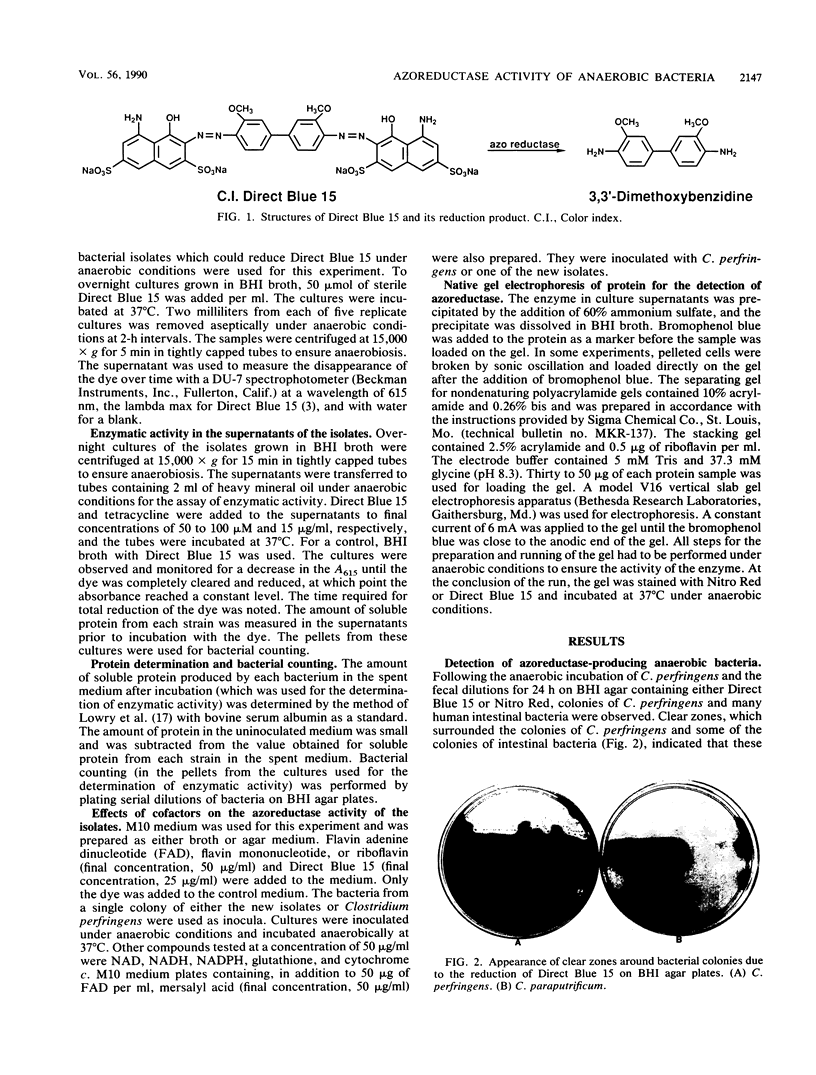
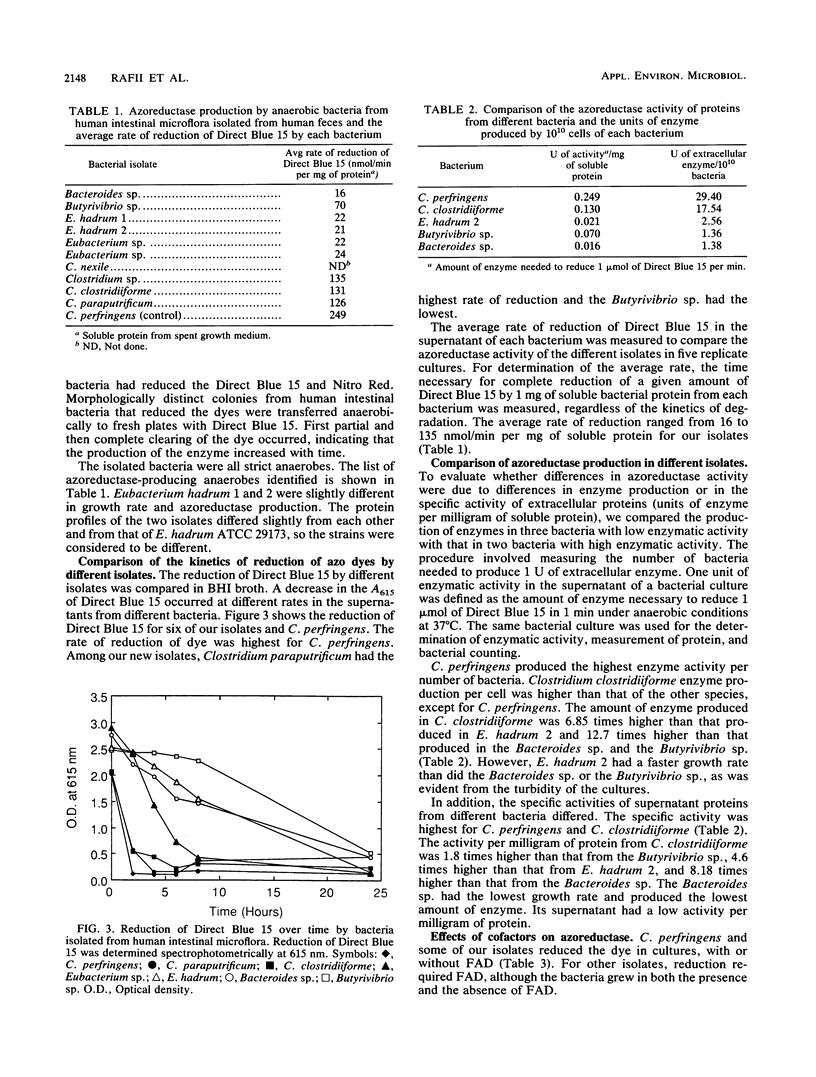
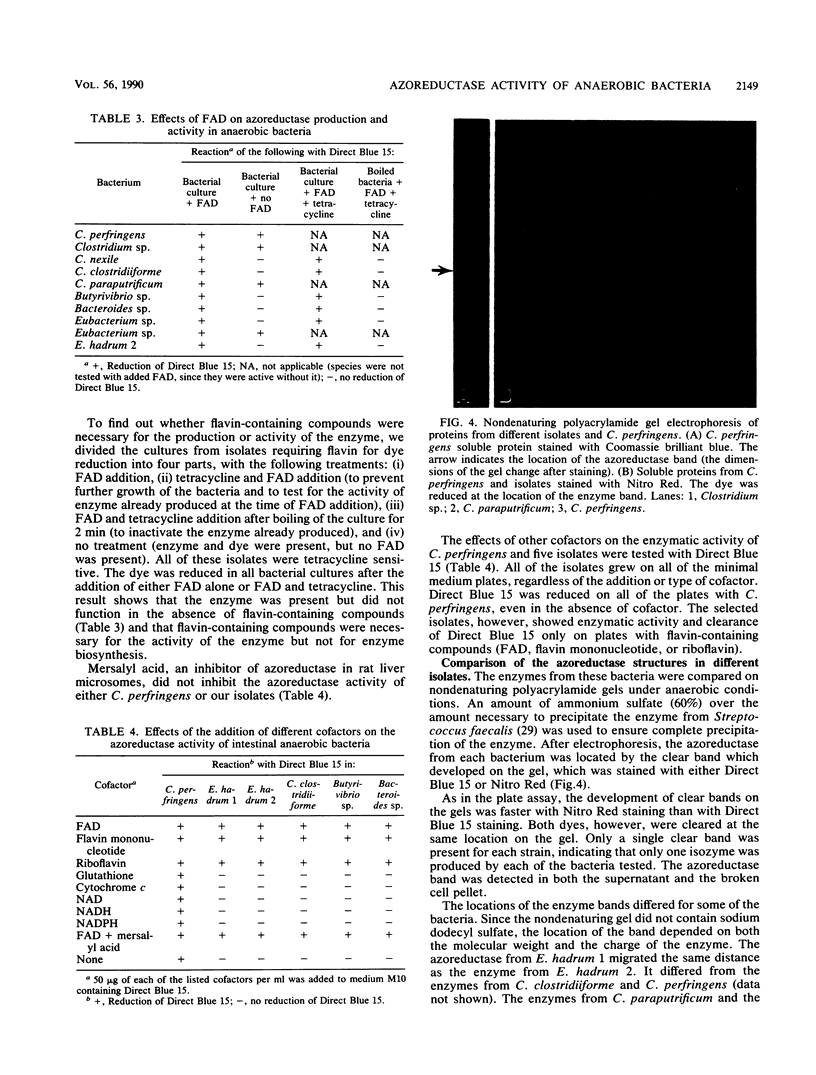
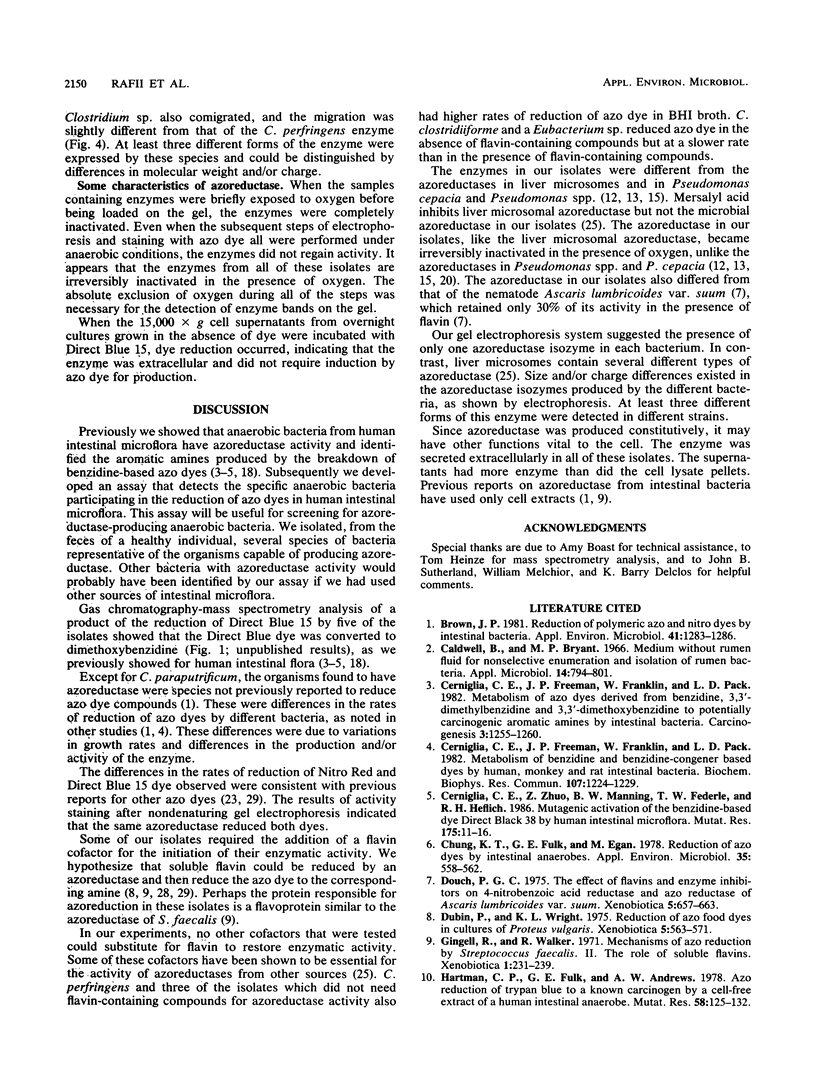
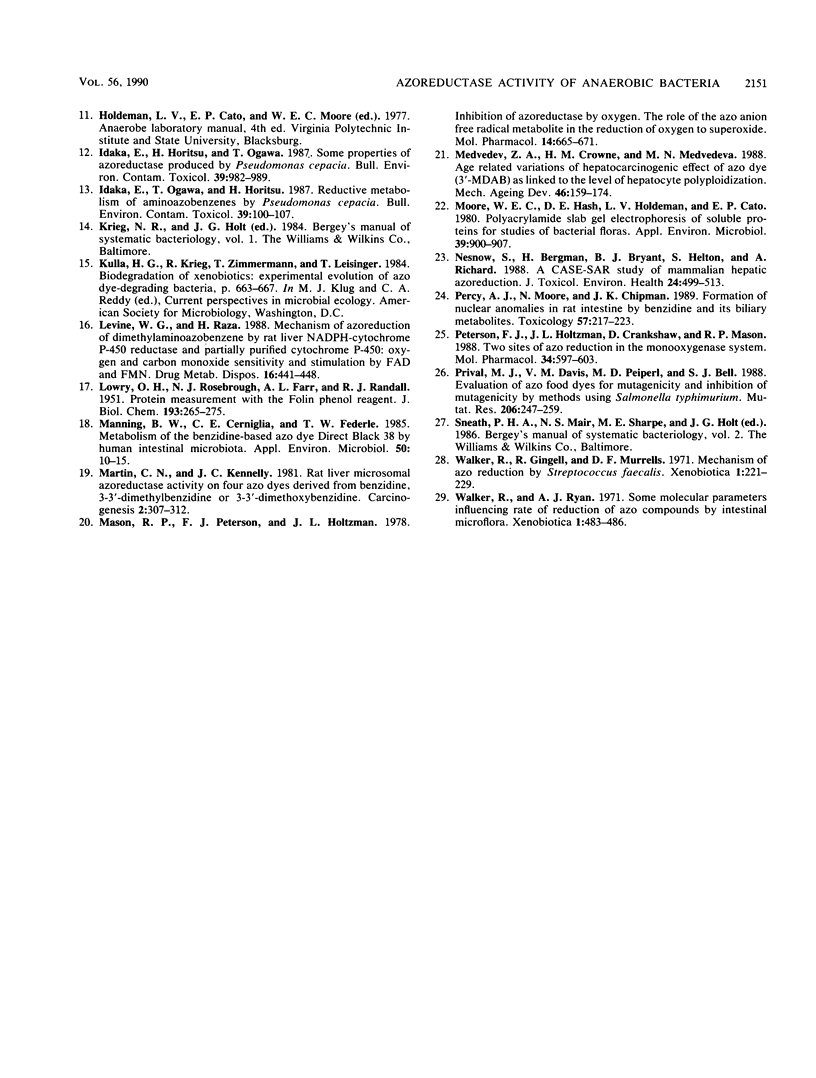
Images in this article
Selected References
These references are in PubMed. This may not be the complete list of references from this article.
- Brown J. P. Reduction of polymeric azo and nitro dyes by intestinal bacteria. Appl Environ Microbiol. 1981 May;41(5):1283–1286. doi: 10.1128/aem.41.5.1283-1286.1981. [DOI] [PMC free article] [PubMed] [Google Scholar]
- Caldwell D. R., Bryant M. P. Medium without rumen fluid for nonselective enumeration and isolation of rumen bacteria. Appl Microbiol. 1966 Sep;14(5):794–801. doi: 10.1128/am.14.5.794-801.1966. [DOI] [PMC free article] [PubMed] [Google Scholar]
- Cerniglia C. E., Freeman J. P., Franklin W., Pack L. D. Metabolism of azo dyes derived from benzidine, 3,3'-dimethyl-benzidine and 3,3'-dimethoxybenzidine to potentially carcinogenic aromatic amines by intestinal bacteria. Carcinogenesis. 1982;3(11):1255–1260. doi: 10.1093/carcin/3.11.1255. [DOI] [PubMed] [Google Scholar]
- Cerniglia C. E., Freeman J. P., Franklin W., Pack L. D. Metabolism of benzidine and benzidine-congener based dyes by human, monkey and rat intestinal bacteria. Biochem Biophys Res Commun. 1982 Aug 31;107(4):1224–1229. doi: 10.1016/s0006-291x(82)80128-9. [DOI] [PubMed] [Google Scholar]
- Cerniglia C. E., Zhuo Z., Manning B. W., Federle T. W., Heflich R. H. Mutagenic activation of the benzidine-based dye direct black 38 by human intestinal microflora. Mutat Res. 1986 Sep;175(1):11–16. doi: 10.1016/0165-7992(86)90138-7. [DOI] [PubMed] [Google Scholar]
- Chung K. T., Fulk G. E., Egan M. Reduction of azo dyes by intestinal anaerobes. Appl Environ Microbiol. 1978 Mar;35(3):558–562. doi: 10.1128/aem.35.3.558-562.1978. [DOI] [PMC free article] [PubMed] [Google Scholar]
- Douch P. G. The effect of flavins and enzyme inhibitors on 4-nitrobenzoic acid reductase and azo reductase of Ascaris lumbricoides var suum. Xenobiotica. 1975 Nov;5(11):657–663. doi: 10.3109/00498257509056135. [DOI] [PubMed] [Google Scholar]
- Dubin P., Wright K. L. Reduction of azo food dyes in cultures of Proteus vulgaris. Xenobiotica. 1975 Sep;5(9):563–571. doi: 10.3109/00498257509056126. [DOI] [PubMed] [Google Scholar]
- Gingell R., Walker R. Mechanisms of azo reduction by Streptococcus faecalis. II. The role of soluble flavins. Xenobiotica. 1971 May;1(3):231–239. doi: 10.3109/00498257109033172. [DOI] [PubMed] [Google Scholar]
- Hartman C. P., Fulk G. E., Andrews A. W. Azo reduction of trypan blue to a known carcinogen by a cell-free extract of a human intestinal anaerobe. Mutat Res. 1978 Nov;58(2-3):125–132. doi: 10.1016/0165-1218(78)90001-0. [DOI] [PubMed] [Google Scholar]
- Idaka E., Horitsu H., Ogawa T. Some properties of azoreductase produced by Pseudomonas cepacia. Bull Environ Contam Toxicol. 1987 Dec;39(6):982–989. doi: 10.1007/BF01689588. [DOI] [PubMed] [Google Scholar]
- Idaka E., Ogawa T., Horitsu H. Reductive metabolism of aminoazobenzenes by Pseudomonas cepacia. Bull Environ Contam Toxicol. 1987 Jul;39(1):100–107. doi: 10.1007/BF01691796. [DOI] [PubMed] [Google Scholar]
- LOWRY O. H., ROSEBROUGH N. J., FARR A. L., RANDALL R. J. Protein measurement with the Folin phenol reagent. J Biol Chem. 1951 Nov;193(1):265–275. [PubMed] [Google Scholar]
- Levine W. G., Raza H. Mechanism of azoreduction of dimethylaminoazobenzene by rat liver NADPH-cytochrome P-450 reductase and partially purified cytochrome P-450. Oxygen and carbon monoxide sensitivity and stimulation by FAD and FMN. Drug Metab Dispos. 1988 May-Jun;16(3):441–448. [PubMed] [Google Scholar]
- Manning B. W., Cerniglia C. E., Federle T. W. Metabolism of the benzidine-based azo dye Direct Black 38 by human intestinal microbiota. Appl Environ Microbiol. 1985 Jul;50(1):10–15. doi: 10.1128/aem.50.1.10-15.1985. [DOI] [PMC free article] [PubMed] [Google Scholar]
- Martin C. N., Kennelly J. C. Rat liver microsomal azoreductase activity on four azo dyes derived from benzidine, 3,3'-dimethylbenzidine or 3,3'-dimethoxybenzidine. Carcinogenesis. 1981;2(4):307–312. doi: 10.1093/carcin/2.4.307. [DOI] [PubMed] [Google Scholar]
- Mason R. P., Peterson F. J., Holtzman J. L. Inhibition of azoreductase by oxygen. The role of the azo anion free radical metabolite in the reduction of oxygen to superoxide. Mol Pharmacol. 1978 Jul;14(4):665–671. [PubMed] [Google Scholar]
- Medvedev Z. A., Crowne H. M., Medvedeva M. N. Age related variations of hepatocarcinogenic effect of azo dye (3'-MDAB) as linked to the level of hepatocyte polyploidization. Mech Ageing Dev. 1988 Dec;46(1-3):159–174. doi: 10.1016/0047-6374(88)90123-6. [DOI] [PubMed] [Google Scholar]
- Moore W. E., Hash D. E., Holdeman L. V., Cato E. P. Polyacrylamide slab gel electrophoresis of soluble proteins for studies of bacterial floras. Appl Environ Microbiol. 1980 Apr;39(4):900–907. doi: 10.1128/aem.39.4.900-907.1980. [DOI] [PMC free article] [PubMed] [Google Scholar]
- Nesnow S., Bergman H., Bryant B. J., Helton S., Richard A. A CASE-SAR study of mammalian hepatic azoreduction. J Toxicol Environ Health. 1988;24(4):499–513. doi: 10.1080/15287398809531180. [DOI] [PubMed] [Google Scholar]
- Percy A. J., Moore N., Chipman J. K. Formation of nuclear anomalies in rat intestine by benzidine and its biliary metabolites. Toxicology. 1989 Jul 17;57(2):217–223. doi: 10.1016/0300-483x(89)90167-4. [DOI] [PubMed] [Google Scholar]
- Peterson F. J., Holtzman J. L., Crankshaw D., Mason R. P. Two sites of azo reduction in the monooxygenase system. Mol Pharmacol. 1988 Oct;34(4):597–603. [PubMed] [Google Scholar]
- Prival M. J., Davis V. M., Peiperl M. D., Bell S. J. Evaluation of azo food dyes for mutagenicity and inhibition of mutagenicity by methods using Salmonella typhimurium. Mutat Res. 1988 Oct;206(2):247–259. doi: 10.1016/0165-1218(88)90168-1. [DOI] [PubMed] [Google Scholar]
- Walker R., Gingell R., Murrells D. F. Mechanisms of azo reduction by Streptococcus faecalis. I. Optimization of assay conditions. Xenobiotica. 1971 May;1(3):221–229. doi: 10.3109/00498257109033171. [DOI] [PubMed] [Google Scholar]
- Walker R., Ryan A. J. Some molecular parameters influencing rate of reduction of azo compounds by intestinal microflora. Xenobiotica. 1971 Jul-Oct;1(4):483–486. doi: 10.3109/00498257109041513. [DOI] [PubMed] [Google Scholar]




